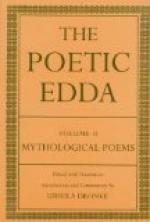The remaining poems of the cycle, all late in style and tone, deal with the fates of Gudrun and her brothers, and owe their existence to a narrator’s unwillingness to let a favourite story end. The curse makes continuation easy, since the Giukings inherit it with the hoard. Gudrun was married at the wish of her kinsmen to Atli the Hun, said to be Brynhild’s brother. He invited Gunnar and Hoegni to his court and killed them for the sake of the treasure, in vengeance for which Gudrun killed her own two sons and Atli; this latter incident being possibly an imitation of Signy. If we may believe that Gudrun, like Chriemhild in the Nibelungen Lied, married Atli in order to gain vengeance for Sigurd, we might suppose that there was confusion here: that she herself incited the murder of her brothers, and killed Atli when he had served his purpose. This would strengthen the part of Gudrun, who as the tale stands is rather a futile character. But in all probability the episode is due to a confusion of Signy’s story with that of the German Chriemhild and Etzel.
One point has still to be considered: the place of the Nibelungs in the story. In the Edda, the Hniflungs are always the Giukings, Gunnar and Hoegni, and Snorri gives it as the name of an heroic family. The title of the first aventiure of the Nibelungen Lied also apparently uses the word of the Burgundians. Yet the treasure is always the Nibelungs’ hoard, which clearly means that they were the original owners; and when Hagen von Tronje tells the story later in the poem, he speaks of the Nibelungs correctly as the dwarfs from whom Siegfried won it. On this point, therefore, the German preserves the older tradition: the Norse Andvari, the river-dwarf, is the German Alberich the Nibelung. In the Nibelungen Lied the winning of the treasure forms no part of the action: it is merely narrated by Hagen. This accounts for the shortening of the episode and the omission of the intermediate steps: the robbing of the dwarf, the curse, and the dragon-slaying.
* * * * *
Ermanric.—The two poems of Gudrun’s Lament and Hamthismal, in the Edda attached to the Volsung cycle, belong correctly to that of the Gothic hero Ermanric. According to these poems, Gudrun, Giuki’s daughter, married a third time, and had three sons, Soerli, Hamthi and Erp. She married Svanhild, her own and Sigurd’s daughter, to Joermunrek, king of the Goths; but Svanhild was slandered, and her husband had her trodden to death by horses’ hoofs. The description of Svanhild is a good example of the style of the romantic poems:
“The bondmaids sat round Svanhild, dearest of my children; Svanhild was like a glorious sunbeam in my hall. I dowered her with gold and goodly fabrics when I married her into Gothland. That was the hardest of my griefs, when they trod Svanhild’s fair hair into the dust beneath the horses’ hoofs.”




